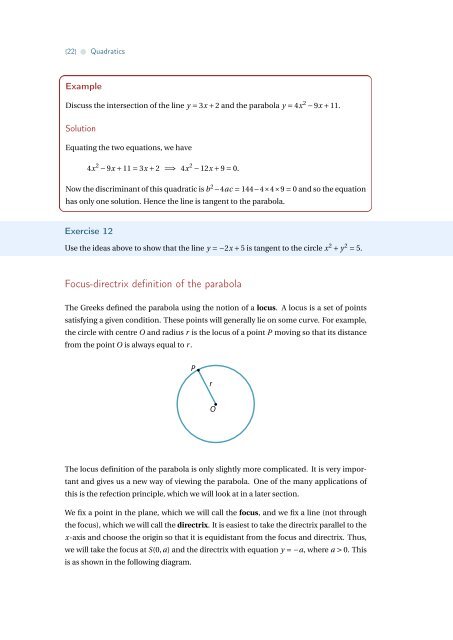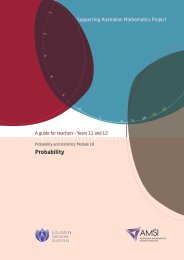Quadratics - the Australian Mathematical Sciences Institute
Quadratics - the Australian Mathematical Sciences Institute
Quadratics - the Australian Mathematical Sciences Institute
You also want an ePaper? Increase the reach of your titles
YUMPU automatically turns print PDFs into web optimized ePapers that Google loves.
{22} • <strong>Quadratics</strong><br />
Example<br />
Discuss <strong>the</strong> intersection of <strong>the</strong> line y = 3x + 2 and <strong>the</strong> parabola y = 4x 2 − 9x + 11.<br />
Solution<br />
Equating <strong>the</strong> two equations, we have<br />
4x 2 − 9x + 11 = 3x + 2 =⇒ 4x 2 − 12x + 9 = 0.<br />
Now <strong>the</strong> discriminant of this quadratic is b 2 −4ac = 144−4×4×9 = 0 and so <strong>the</strong> equation<br />
has only one solution. Hence <strong>the</strong> line is tangent to <strong>the</strong> parabola.<br />
Exercise 12<br />
Use <strong>the</strong> ideas above to show that <strong>the</strong> line y = −2x + 5 is tangent to <strong>the</strong> circle x 2 + y 2 = 5.<br />
Focus-directrix definition of <strong>the</strong> parabola<br />
The Greeks defined <strong>the</strong> parabola using <strong>the</strong> notion of a locus. A locus is a set of points<br />
satisfying a given condition. These points will generally lie on some curve. For example,<br />
<strong>the</strong> circle with centre O and radius r is <strong>the</strong> locus of a point P moving so that its distance<br />
from <strong>the</strong> point O is always equal to r .<br />
P<br />
r<br />
O<br />
The locus definition of <strong>the</strong> parabola is only slightly more complicated. It is very important<br />
and gives us a new way of viewing <strong>the</strong> parabola. One of <strong>the</strong> many applications of<br />
this is <strong>the</strong> refection principle, which we will look at in a later section.<br />
We fix a point in <strong>the</strong> plane, which we will call <strong>the</strong> focus, and we fix a line (not through<br />
<strong>the</strong> focus), which we will call <strong>the</strong> directrix. It is easiest to take <strong>the</strong> directrix parallel to <strong>the</strong><br />
x-axis and choose <strong>the</strong> origin so that it is equidistant from <strong>the</strong> focus and directrix. Thus,<br />
we will take <strong>the</strong> focus at S(0, a) and <strong>the</strong> directrix with equation y = −a, where a > 0. This<br />
is as shown in <strong>the</strong> following diagram.
















